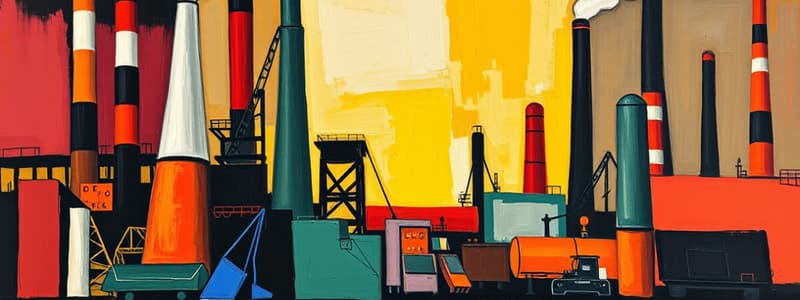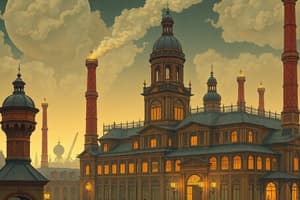Podcast
Questions and Answers
What are the new/main industries in the Second Industrial Revolution?
What are the new/main industries in the Second Industrial Revolution?
- Electric power
- Chemical power
- Bessemer process (steel)
- All of the above (correct)
What is the key difference between the first and second Industrial Revolutions?
What is the key difference between the first and second Industrial Revolutions?
The second Industrial Revolution was larger and included the development of electricity, chemicals, oil, and steel, while the first transitioned from manpower to machine power.
What was the most revolutionary development of the Second Industrial Revolution?
What was the most revolutionary development of the Second Industrial Revolution?
Streetcar
Name some new inventions from the Second Industrial Revolution.
Name some new inventions from the Second Industrial Revolution.
What are the new energy sources during the Second Industrial Revolution?
What are the new energy sources during the Second Industrial Revolution?
Which country was the leading industrial power during the Second Industrial Revolution?
Which country was the leading industrial power during the Second Industrial Revolution?
What is a cartel?
What is a cartel?
What was a response of many countries to increased competition for foreign markets?
What was a response of many countries to increased competition for foreign markets?
Which of the following are types of employment during the Second Industrial Revolution?
Which of the following are types of employment during the Second Industrial Revolution?
What were the gender roles of women during this period?
What were the gender roles of women during this period?
What characterized Socialist parties in the late 19th century?
What characterized Socialist parties in the late 19th century?
What was the largest, most successful social party during this time?
What was the largest, most successful social party during this time?
Who is Eduard Bernstein and what is 'Evolutionary Socialism'?
Who is Eduard Bernstein and what is 'Evolutionary Socialism'?
What does revisionism refer to in a social context?
What does revisionism refer to in a social context?
What was the role of trade unions during this period?
What was the role of trade unions during this period?
Where was the anarchist movement most successful?
Where was the anarchist movement most successful?
Which countries experienced high emigration to non-European regions?
Which countries experienced high emigration to non-European regions?
What demographic changes occurred in urban and rural areas?
What demographic changes occurred in urban and rural areas?
How did art differ between the late 19th century and the Renaissance?
How did art differ between the late 19th century and the Renaissance?
What were the status and issues faced by Austria-Hungary?
What were the status and issues faced by Austria-Hungary?
How did Spain and Italy compare to western European powers during the late 19th century?
How did Spain and Italy compare to western European powers during the late 19th century?
What was the primary reason for population growth during this period?
What was the primary reason for population growth during this period?
What were the reasons for the rising standard of living?
What were the reasons for the rising standard of living?
What urban improvements were made during this time?
What urban improvements were made during this time?
What invention most improved living conditions in urban environments?
What invention most improved living conditions in urban environments?
What did Irish home rule call for?
What did Irish home rule call for?
What characterized mass politics during this time?
What characterized mass politics during this time?
What was Kulterkampf?
What was Kulterkampf?
What was the biggest challenge faced by France's Third Republic?
What was the biggest challenge faced by France's Third Republic?
What were the effects of Wilhelm II taking the throne in Germany?
What were the effects of Wilhelm II taking the throne in Germany?
What were Bismarck's failures and successes?
What were Bismarck's failures and successes?
What were the typical family sizes during this time?
What were the typical family sizes during this time?
Study Notes
New/Main Industries
- Key industries of the Second Industrial Revolution included electric power, chemical power, the Bessemer process for steel production, and oil.
Differences Between Industrial Revolutions
- The Second Industrial Revolution was larger and marked by major advancements in electricity, chemicals, oil, and steel, contrasting with the First Industrial Revolution, which shifted from manual to machine power.
Revolutionary Developments
- The introduction of the streetcar transformed urban transport.
New Inventions
- Innovations of this era featured streetcars, telephones, radios, and advancements in steel production.
Energy Sources
- Primary energy sources drove industrial growth included oil and electricity.
Leading Industrial Power
- Germany emerged as the leading industrial nation during this era.
Cartels
- Independent companies collaborated in cartels to control pricing and production limits.
Trade Restrictions & Tariffs
- Many nations implemented protective tariffs in response to heightened international competition.
Types of Employment
- Employment opportunities expanded to include roles such as domestic servants, secretaries, teachers, and nurses.
Gender Roles of Women
- The cult of domesticity defined women’s roles primarily as housewives.
Characteristics of Socialist Parties
- In the late 19th century, socialist parties focused on elections and governmental involvement to improve working-class conditions.
Largest Social Party
- The German Social Democratic Party was noted as the most prominent and successful socialist party.
Eduard Bernstein and "Evolutionary Socialism"
- Bernstein argued that socialism should be achieved through democratic processes rather than revolutions.
Revisionism
- Workers could progress towards their goals through democratic means, negating the need for revolutionary strategies.
Role of Trade Unions
- Trade unions functioned as support groups providing mutual aid to the working class.
Anarchist Movement
- The anarchist movement flourished in nations with unstable governments.
High Emigration Countries
- Italy, Germany, Ireland, and Great Britain experienced significant emigration to non-European regions.
Demographic Changes
- A significant population shift occurred as more people moved from rural areas to urban centers.
Art in the 19th Century vs. Renaissance
- Art during the Renaissance was largely influenced by patronage, while late 19th-century art saw diminished patronage support.
Austria-Hungary's Status and Issues
- Nationality crises in Austria-Hungary remained unresolved until the outbreak of World War I.
Spain & Italy in the Late 19th Century
- Both countries lagged behind western European powers in industrialization.
Primary Reason for Population Growth
- The decline in mortality rates significantly contributed to population increases.
Rising Standard of Living
- Falling birth rates were a key factor in the rising standard of living.
Urban Improvements
- Urban areas saw advancements like public parks, organized sports, improved public health standards, public transportation systems, and the rise of consumer culture.
Key Urban Invention
- The electric streetcar was pivotal in enhancing living conditions in cities.
Irish Home Rule
- The movement called for establishing an Irish parliament while remaining part of Great Britain.
Characteristics of Mass Politics
- Mass politics emerged with expanded suffrage, heightened political interest, increased governmental involvement in daily life, and improved living standards.
Kulterkampf
- Bismarck’s policy aimed to limit Catholic political influence in Germany.
Challenges of France's Third Republic
- The collapse of the Second French Empire and subsequent violence from the Paris Commune represented significant challenges to stability.
Effects of Wilhelm II's Ascendency
- Wilhelm II's reign led to Bismarck's resignation and a marked decline in Germany’s diplomatic stability.
Bismarck's Legacy
- Bismarck initiated the kulturkampf and established a social security state but ultimately failed to dismantle opposing political parties.
Typical Family Sizes
- In the late 19th century, middle-class birth rates dropped significantly, resulting in fewer children per family and contributing to a higher standard of living.
Studying That Suits You
Use AI to generate personalized quizzes and flashcards to suit your learning preferences.
Description
Test your knowledge with these flashcards on the Second Industrial Revolution. Explore significant terms such as new industries, the progression from manpower to machine power, and innovations like electricity and steel. Perfect for students studying industrial history.




